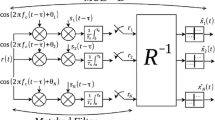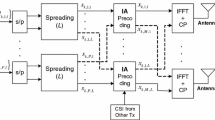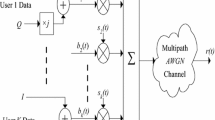Abstract
Through an analytical study of both parallel interference cancellation, decorrelating and MMSE detections in a DS-CDMA (direct-sequence code-division multiple-access) scheme, we derive simple improvements of the previous first structure to achieve better bit-error-rate performance. These schemes are compared with threshold-aided parallel interference cancellation via simulation results over various channels. The signal processing we used is quantified (baseband signals and fixed point calculations) and the synchronization is achieved dynamically as a realistic structure would do.
Résumé
À travers une étude analytique de la suppression paralléle des brouillages, des méthodes de décorrélation et de détection basée sur I’erreur quadratique moyenne, dans un systéme CDMA, l’article propose des améliorations simples d’une précédente structure de réception, permettant l’obtention de meilleures performances. Ces structures sont ensuite comparées avec la suppression seuillée, des brouillages, via des résultats de simulation et différents modèles de canaux. Le traitement de signal mis en œuvre présente la particularité d’être quantifié (signaux en bande de base et calculs en virgule fixe) et la synchronisation est acquise de manière dynamique comme une structure réaliste le ferait.
Similar content being viewed by others
References
Boulanger (C), Ouvry (L.), Bouvier Des Noes (M.), Andre(G.), Fixed point multistage cdma receivers, Proceedings SEE EPMCC,pp. 119–126,(1999).
Lequepeys (J. R.), Ouvry (L.), Boulanger (C), Lattard (D.), Varreau (D.), Daniele (N.), Piaget (B.), Bouvier Des Noes (M.). Modires, Cessium, Picplus, Ceres : and innovative family of dsss/cdma asics for implementing dsss/cdma receivers. Proceedings SEEEPMCC, pp. 225–230, (1999).
Simon (M. K.), Omura (J. K.), Scholtz (R. A.), Levitt (B. K.). Spread spectrum communications, Vol. I-III, Computer Science Press, Maryland, 1985.
Buehrer (R. M), Woerner (B. D.). The asymptotic efficiency of multistage cancellation receivers, Proceedings IEEE PIMRC, pp. 570–574, (1997).
Schilling (D. L.). Wireless communications going into the 21st century, IEEE Transactions on Vehicular Technology, pp. 645–652, (Aug. 1994).
Lehnert (J. S.), Pursley (M. B.). Multipath diversity reception of spread-spectrum multiple-access communications, IEEE Transactions on Communications, pp. 1189–1198, (Nov. 1987).
Viterbi (A. J.). The evolution of digital wireless technology from space exploration to personal communication services, IEEE Transactions on Vehicular Technology, pp. 638–644, (Aug. 1994).
Gilhousen (K. S.). Jacobs (I. M.), Padovani (R.), Viterbi (A. J.), Weaver (L. A.), Wheatly (C. E.), On the capacity of a cellular cdma system, IEEE Transactions on Vehicular Technology, pp. 303–312, (May 1991).
Pickholtz (R. L.), Milstein (L. B.), Schilling (D. L). Spread spectrum for mobile communications, IEEE Transactions on Vehicular Technology, pp. 313–322, (May 1991).
Lee (W. C. Y.). Overview of cellular cdma, IEEE Transactions on Vehicular Technology, pp. 291–302, (May 1991).
Scholtz (R. A.). The origins of spread-spectrum communications, IEEE Transactions on Communications, pp. 822–854, (May 1982).
Sarwate (D.W.), Pursley (M. B.). Crosscorrelation properties of pseudorandom and related sequences, Proceedings of the IEEE, pp. 593–619, (May 1980).
Verdu (S.). Minimum probability of error for asynchronous Gaussian multiple-access channels,IEEE Transactions on Information Theory, pp. 85–96, (Jan. 1986).
Iltis (R. A.), Mailaender (L.). An adaptive multiuser detector with joint amplitude and delay estimation, IEEE Transactions on Communications, pp. 578–583, (May 1990).
Dahlhaus (D.), Fleury (B. H.), Radovic (A.). A sequential algorithm for joint parameter estimation and multiuser detection in ds/cdma systems with multipath propagation, Wireless Personal Communications Journal, pp. 161–178, (1998).
*** Utra Physical layer description, ETSI UMTS 1998, FDD parts, V0. 3, (29-05-1998).
Lupas (R.), Verdu (S.). Near-far resistance of multi-user detectors in asynchronous channels, IEEE Transactions on Communications, pp. 496–508, (April 1990).
Xie (Z.), Short (R. T.), Rushforth (S. H.). A family of subopti-mum detectors for coherent multi-user communications, IEEE Journal on Selected Areas in Communications. pp. 683–690, (May 1990).
Varanasi (M. K.), Aazhang (B.). Multistage detection in asynchronous code-division multiple-access communications. IEEE Transactions on Communications, pp. 509–519, (April 1990).
Lequepeys (J. R.), Daniele (N.), Lattard (D.), Piaget (B.), Varreau (D.), Ouvry (L.), Boulanger (C). Cessium: a single component for implementing high data rates dsss/cdma interference cancellation receivers, Proceedings IEEE ISSSTA, pp. 888–892, (1998).
Divsalar (D.), Simon (M. K.). Improved cdma performance using parallel interference cancellation, Proceedings IEEE MILCOM, pp. 911–917, (1994).
Moshavi (S.), Schilling (D. L.), Kowalski (J.). Spread spectrum cdma subtractive interference canceler and method. United States patent N° 5363403, 8/11/1994.
Moshavi (S.), Kanterakis (E.), Schilling (D. L.). Multistage linear receivers for ds-cdma systems, International Journal of Wireless Information Networks, pp. 1–17, 1996.
Boulanger (C), Ouvry (L.), Multistage linear ds-cdma receivers, Proceedings IEEE ISSSTA, pp. 663–667, (1998).
Honig (M.), Madhow (U.), Verdu (S.). Blind adaptative multiuser detection, IEEE Transactions on Information Theory, pp. 944–960, (1995).
Boulanger (C), Bouvier Des Noes (M.), Andre (G.), Ouvry (L.), Daniele (N.), Lequeleys (J. R.). Comparison between various cdma interference cancellation structures under different channel environments, with both theoretical and simulation results. Proceedings VDE EPMCC (1997).
Boulanger (C). Code-division multiple-access : spreading sequence optimization and adequated receiver design, INPG Ph. D. Dissertation, (Sept. 1998).
Patzold (M.), Killat (U.), Laue (F.), Li (Y.). On the problem of Monte Carlo method based simulation models for mobile radio channels, Proceedings IEEE ISSSTA, pp. 1214–1220, (1996).
Boulanger (C), Ouvry (L.), Tabu search : an efficient tool for designing ds-cdma spreading sequences, Proceeedings IEEE ISSSTA, pp. 59–63,(1998).
Author information
Authors and Affiliations
Corresponding author
Additional information
This work was supported by the European project ACTS 083 FRANS. It is protected by patent numbers 98 03586, 98 09782 and 98 11335.
Rights and permissions
About this article
Cite this article
Boulanger, C., Ouvry, L. & Lequepeys, JR. Fixed point multistage DS-CDMA receivers. Ann. Télécommun. 54, 347–358 (1999). https://doi.org/10.1007/BF02997757
Received:
Issue Date:
DOI: https://doi.org/10.1007/BF02997757
Key words
- Code division multiple access
- Direct sequence spread spectrum
- Multistage circuit
- Multichannel circuit
- Signal interference
- Decorrelation
- Mean square error
- Fixed point




